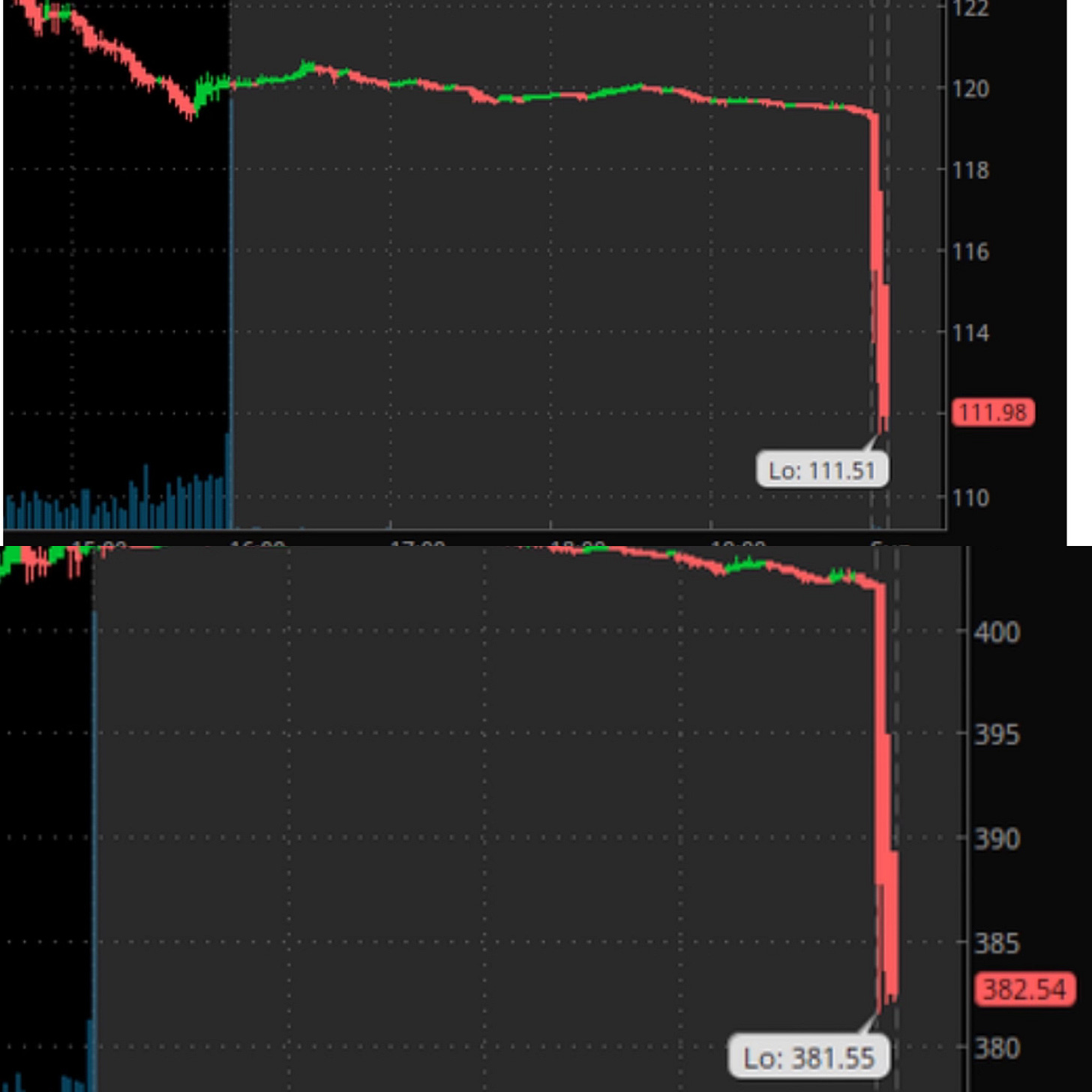With President Trump’s imposition of 25% tariffs on imports from Canada and Mexico, and 10% on Chinese goods, the financial markets are bracing for significant turbulence. Nasdaq futures are already down -3%, signaling a rocky start to the week, with the AI-driven stocks that powered the recent tech rally feeling the pressure. Both Tesla and Nvidia—the two largest stocks in the market, key players in the AI bubble—are already down -7% heading into Monday morning.
This dramatic decline in the tech sector has sent ripples through the broader market, and the effects are spreading. The crypto market, already on edge, is now in full-blown panic mode, with a majority of them crashing by 30% or more overnight. Some investors are unable to withdraw their funds from exchanges, further heightening fears. The storm is coming, and it’s quickly building into a perfect economic storm. As the contagion spreads, concerns of a liquidity crisis and a broader financial collapse are mounting, signaling that the worst may be yet to come.
“You think this can last forever, there’s a storm coming. You and your friends better batten down the hatches because when it hits, you’re all gonna wonder how you ever thought you could live so large and leave so little for the rest of us.” Catwoman’s chilling warning to a complacent Bruce Wayne now echoes ominously across global markets. She wasn’t talking about trade policy—but she might as well have been.
History has shown that tariffs, though often wielded as political weapons, come with devastating economic consequences. Two moments stand out as stark warnings: the Smoot-Hawley Tariff Act (1929-1933), which deepened the Great Depression, and the Trump-era tariffs (2018), which rattled markets and disrupted global supply chains. In both cases, the alarms were sounded, yet ignored, and the fallout was brutal.
Now, with Trade War 2.0 in full swing, the escalation is swift, and financial markets are already unraveling. The AI-fueled Nasdaq is tumbling, speculative crypto markets are imploding overnight, and panicked investors are scrambling for shelter. The storm isn’t on the horizon—it’s here. And when the full force of the reckoning arrives, many will be left asking how they ever believed the boom times could last forever.
The Mechanics of Tariffs: A Tax Some One Pays
Before diving into the hard economic data, it’s essential to understand how tariffs work—and why their effects extend far beyond their intended targets, creating a ripple effect that shakes industries, markets, and consumers alike.
Take Apple, for example. When the California-based tech giant imports iPhones from China under the newly imposed 10% tariff, it faces an unavoidable new tax. Apple must pay an additional 10% levy to U.S. Customs, which then channels the revenue directly into the U.S. Treasury. From there, the funds are absorbed into government reserves, helping to finance federal spending and broader budgetary plans.
But Apple, like any corporation, won’t absorb this cost without a fight. Faced with this added expense, it has only a handful of options—none of which are painless:
• Absorb the Cost – Profits shrink (causing the stock to crash)
• Raise Prices – Consumers foot the bill, weakening demand and slowing sales (causing the stock to crash)
• Cut Product Features – Fewer included accessories, lower-quality components, and diminished value for buyers.
• Lay Off Workers – Reduced labor costs help offset tariffs, but at the expense of jobs (hurst the economy)
• A Combination of These Strategies – A balancing act that ultimately dampens economic growth.
Each of these choices sets off a chain reaction—higher prices mean less consumer spending, shrinking profits lead to layoffs, and reduced investment stifles innovation and competitiveness. Tariffs don’t just tax imports; they tax the entire economy, dragging down growth, fueling uncertainty, and destabilizing financial markets.
(A 60% tariff on Chinese goods & 20% on others would drive U.S. tariffs above 20% higher than the 1930s. Costs for businesses would 📈, profits 📉and leading to major stock 📉. Retaliation from trade partners could further hit exports, intensifying market instability)
The Hoover Storm: 1929-1933
In a striking parallel to today’s escalating trade wars, President Herbert Hoover—like President Trump nearly a century later—believed tariffs were the key to protecting American industry and labor. Hoover championed the Smoot-Hawley Tariff Act of 1930, a sweeping protectionist measure that raised duties on more than 20,000 imported goods. His goal was simple: shield American businesses and workers from foreign competition. But instead of prosperity, the result was economic catastrophe.
The Rationale Behind Hoover’s Protectionism
Hoover’s commitment to tariffs was rooted in two core beliefs:
1. Shielding American Workers – Higher tariffs, he argued, would prevent cheap foreign labor from undercutting American wages.
2. Protecting Domestic Industry – By making imports more expensive, domestic producers would be insulated from global competition.
Yet, these well-intentioned policies unleashed an economic disaster of historic proportions—one that transformed a severe recession into a full-scale depression.
Economic Collapse: The Fallout from Smoot-Hawley
The impact of Hoover’s tariffs was swift and devastating:
• GDP Freefall – The U.S. economy contracted by -29% from 1929 to 1933, with GNP collapsing from $103.1 billion to $55.6 billion.
• Unemployment Catastrophe – Joblessness soared from 8% in 1930 to 25% by 1933, leaving 12.8 million Americans without work.
• Stock Market Carnage – The Dow Jones Industrial Average cratered by -89%, plunging from 381 in 1929 to just 41 by 1932.
• Global Trade in Ruins – U.S. imports shrank by -66%, exports plummeted by -61%, and world trade collapsed by two-thirds between 1929 and 1934.
Keep reading with a 7-day free trial
Subscribe to The Coastal Journal to keep reading this post and get 7 days of free access to the full post archives.






